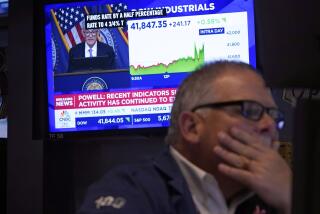Major Banks Lower Prime Rate to 10.5% : Federal Reserve’s Easing of Credit Triggers Action
NEW YORK — Several major commercial banks, including the nation’s largest, lowered their prime lending rates a half percentage point today to 10.5%, signaling lower borrowing costs for consumers and businesses.
First Bank of Chicago was the first to take the step shortly before the opening of the stock market, with Chemical Bank, Continental Bank, Morgan Guaranty Trust Co., Manufacturers Hanover Trust Co., Bankers Trust Co., No. 1 Citibank and Security Pacific National Bank joining in.
The reduction, effective immediately, follows similar cuts by San Francisco-based Bank of America on Friday and Chase Manhattan Bank more than three weeks ago. A few other smaller banks have reduced their prime rates since Chase’s move.
Bank’s Cost
The prime rate reflects a bank’s costs of borrowing money, including interest it pays on savings accounts or certificates of deposit, and trails more subtle increases in other interest rates.
The rate is watched closely because bankers use it as a basis for calculating loans to businesses and for determining many types of fixed and adjustable-rate consumer loans. Mortgage rates are not included in that category.
Today’s decrease was widely expected by most economists due to continuing signs that the Federal Reserve is seeking looser credit policies in response to a slowdown in economic growth.
Economists have speculated that major banks did not immediately follow Chase, which cut its prime rate on July 10, partly because they wanted to determine whether the Fed would keep pursuing lower interest rates.
“The sentiment in the marketplace was that Chase was too early and everyone else was waiting until the federal funds rate stayed below 9%,” said Elizabeth G. Reiners, an economist with Dean Witter Reynolds Inc.
The federal funds rate, the interest on overnight loans between banks, traded at 8 7/8% by late morning today, down from nearly 9% Friday.
More to Read
Inside the business of entertainment
The Wide Shot brings you news, analysis and insights on everything from streaming wars to production — and what it all means for the future.
You may occasionally receive promotional content from the Los Angeles Times.










